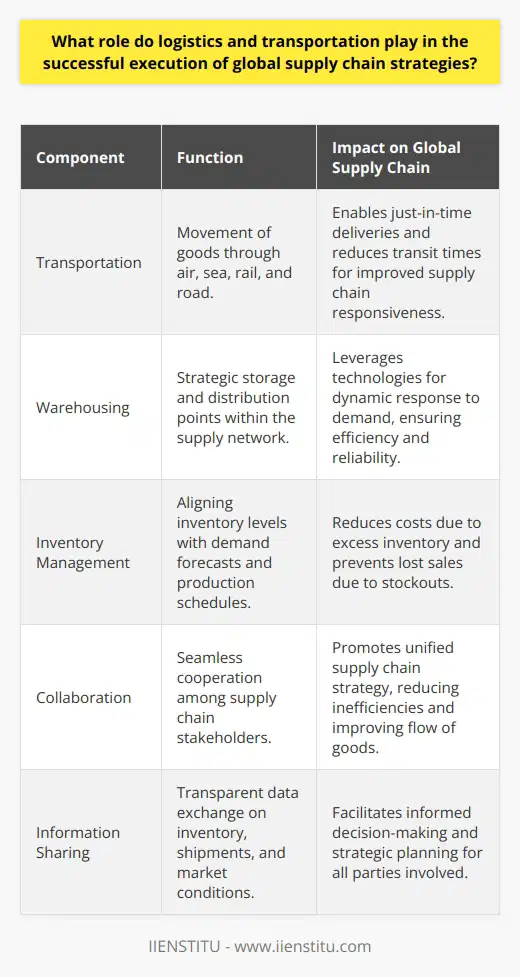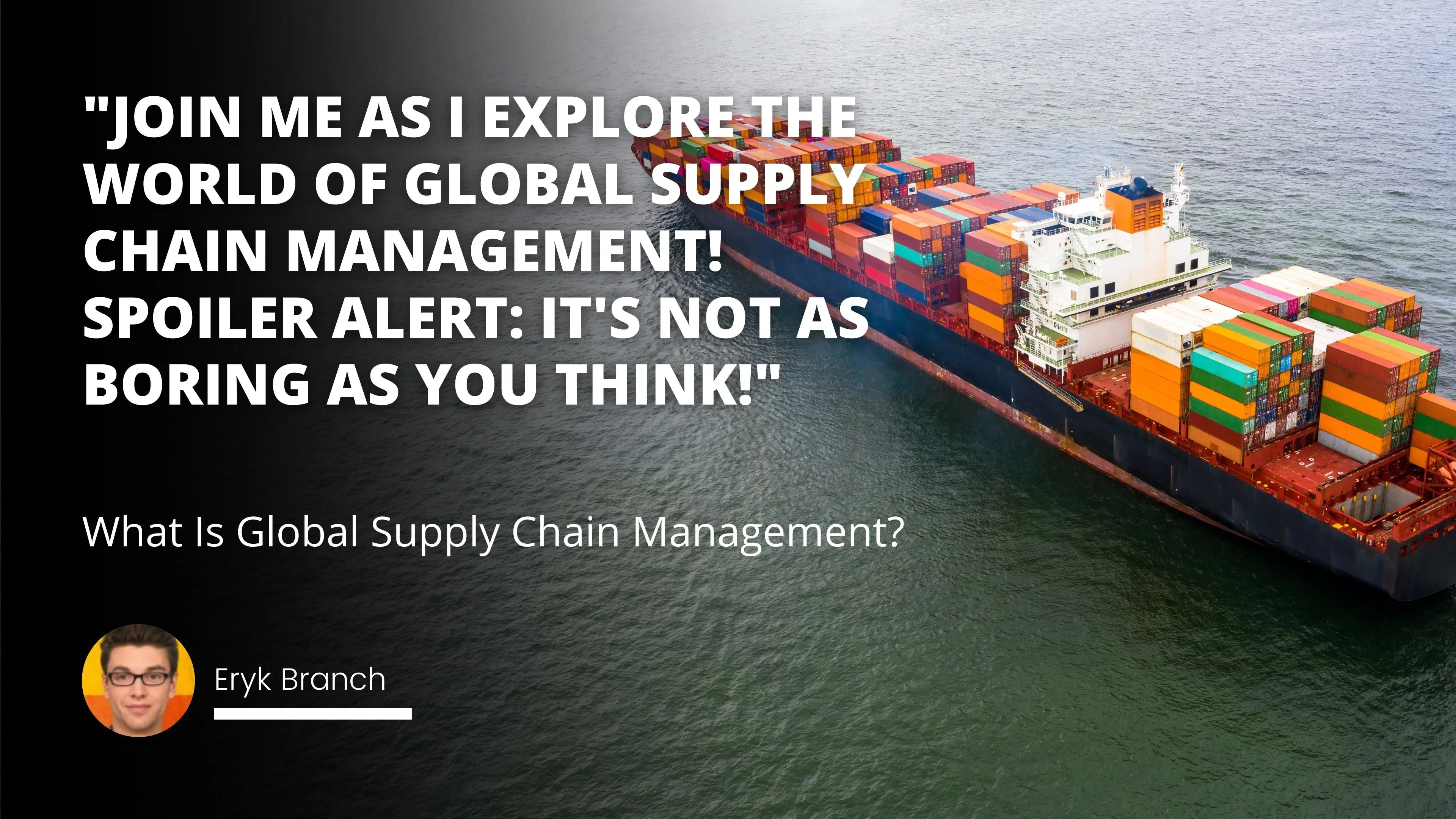
As the world economy continues to globalization, businesses are increasingly looking for ways to optimize their operations and gain a competitive edge. One area that has gained significant attention is global supply chain management (GSCM).
Global supply chain management coordinates and integrates all the activities required to bring a product or service from suppliers to customers. This includes everything from procuring raw materials and components to manufacturing, assembling, and delivering the final product.
GSCM requires a high level of coordination and communication between all parties involved in the supply chain, including suppliers, manufacturers, distributors, retailers, and customers. In addition, GSCM must consider the many factors that can impact the supply chain, such as cultural differences, regulatory requirements, and transportation infrastructure.
The goal of GSCM is to create a supply chain that is efficient and effective in meeting the needs of customers while also minimizing cost and maximizing value. To do this, businesses must carefully plan and manage all aspects of their supply chain, from sourcing and procurement to production and distribution.
Many benefits can be gained from implementing a successful global supply chain management strategy. These benefits include improved customer satisfaction, increased efficiency and productivity, reduced costs, and enhanced competitive advantage.
Global supply chain management is a complex process, but it is essential for businesses that want to stay ahead in today's competitive marketplace. By carefully planning and managing their supply chains, companies can reap the many benefits GSCM offers.
Defining global supply chain management (GSCM)
Global supply chain management, or GSCM, is a strategic approach to managing supply chains worldwide. At its core, GSCM involves coordinating the movement of goods from one location to another using logistics, transport networks, and contract agreements. By optimizing the flow of information and resources across the entire value chain, GSCM effectively ensures that businesses have the raw materials they need and that customers receive high-quality products on time.
Most Searched Prioritize Multiple Shipments İnterview Question
İn-transit Visibility Solutions For İmproved Supply Chain Efficiency
Furthermore, GSCM enables enterprises to stay ahead of consumer preferences and changing market conditions by facilitating quick response times and flexibility in production planning. Overall, regardless of industry or region, global supply chain management is essential for ensuring that businesses worldwide can operate efficiently and profitably.
The benefits of a well-run global supply chain
There are many benefits to be gained from implementing a successful global supply chain management strategy. Perhaps most importantly, GSCM can improve customer satisfaction by ensuring high-quality products are delivered on time. In addition, by streamlining the supply chain and reducing waste, GSCM can also increase efficiency and productivity, leading to reduced costs.
Furthermore, by giving businesses the ability to respond quickly and flexibly to changes in consumer preferences or market conditions, GSCM can also provide a significant competitive advantage.
Despite the many benefits of global supply chain management, some challenges must be overcome. One of the biggest challenges is coordinating the activities of all parties involved in the supply chain, including suppliers, manufacturers, distributors, retailers, and customers. In addition, GSCM must consider the many factors that can impact the supply chain, such as cultural differences, regulatory requirements, and transportation infrastructure.
Another challenge is constantly adapting to changes in the global marketplace. For example, as consumer preferences change, businesses must be able to adjust their production plans accordingly quickly. In addition, as new technologies emerge, companies need to be able to incorporate them into their supply chains to maintain a competitive edge.
Despite the challenges, global supply chain management is essential for businesses that want to stay ahead in today's competitive marketplace. By carefully planning and managing their supply chains, companies can reap the many benefits GSCM offers.
How to optimize your global supply chain
There are several different ways to optimize your global supply chain. Perhaps the most important thing you can do is to carefully plan and manage your supply chain to be as efficient and effective as possible. In addition, you should also make sure to incorporate new technologies into your supply chain as they become available.
Furthermore, you need to know the many factors impacting your supply chain to anticipate and plan for changes. Finally, it would help if you also strive to constantly improve your global supply chain management strategy to stay ahead of your competition.
Several resources are available if you want to learn more about global supply chain management. First, you can find a wealth of information on the subject by simply searching online. In addition, many books and articles have been written on the topic.
Finally, you can also take courses or attend seminars that will teach you about global supply chain management. Whatever route you choose, if you want to improve your understanding of GSCM, plenty of resources are available to help you do so.
The challenges of managing a global supply chain
Global supply chain management is not without its challenges. One of the biggest challenges is coordinating the activities of all parties involved in the supply chain, including suppliers, manufacturers, distributors, retailers, and customers. In addition, GSCM must consider the many factors that can impact the supply chain, such as cultural differences, regulatory requirements, and transportation infrastructure.
Another challenge is constantly adapting to changes in the global marketplace. For example, as consumer preferences change, businesses must be able to adjust their production plans accordingly quickly. In addition, as new technologies emerge, companies need to be able to incorporate them into their supply chains to maintain a competitive edge.
Despite these challenges, global supply chain management is essential for businesses that want to stay ahead in today's competitive marketplace. By carefully planning and managing their supply chains, companies can reap the many benefits GSCM offers.
Tips for streamlining your global supply chain
There are several different ways to streamline your global supply chain. First and foremost, you must carefully plan and manage your supply chain to be as efficient as possible. Additionally, it would help if you considered incorporating new technologies into your supply chain as they become available.
Furthermore, you need to know the many factors impacting your supply chain to anticipate and plan for changes. Finally, it would help if you also strive to constantly improve your global supply chain management strategy to stay ahead of your competition.
Several resources are available if you want to learn more about global supply chain management. First, you can find a wealth of information on the subject by simply searching online. In addition, many books and articles have been written on the topic. Finally, you can also take courses or attend seminars that will teach you about global supply chain management. Whatever route you choose, if you want to improve your understanding of GSCM, plenty of resources are available to help you do so.
Supply chain management is critical for businesses that want to remain competitive in today’s global market. An effective supply chain management strategy can help companies improve their bottom line by reducing costs and increasing efficiencies. If you’re interested in learning more about how to develop and implement a successful supply chain management strategy, join our supply chain management course today.
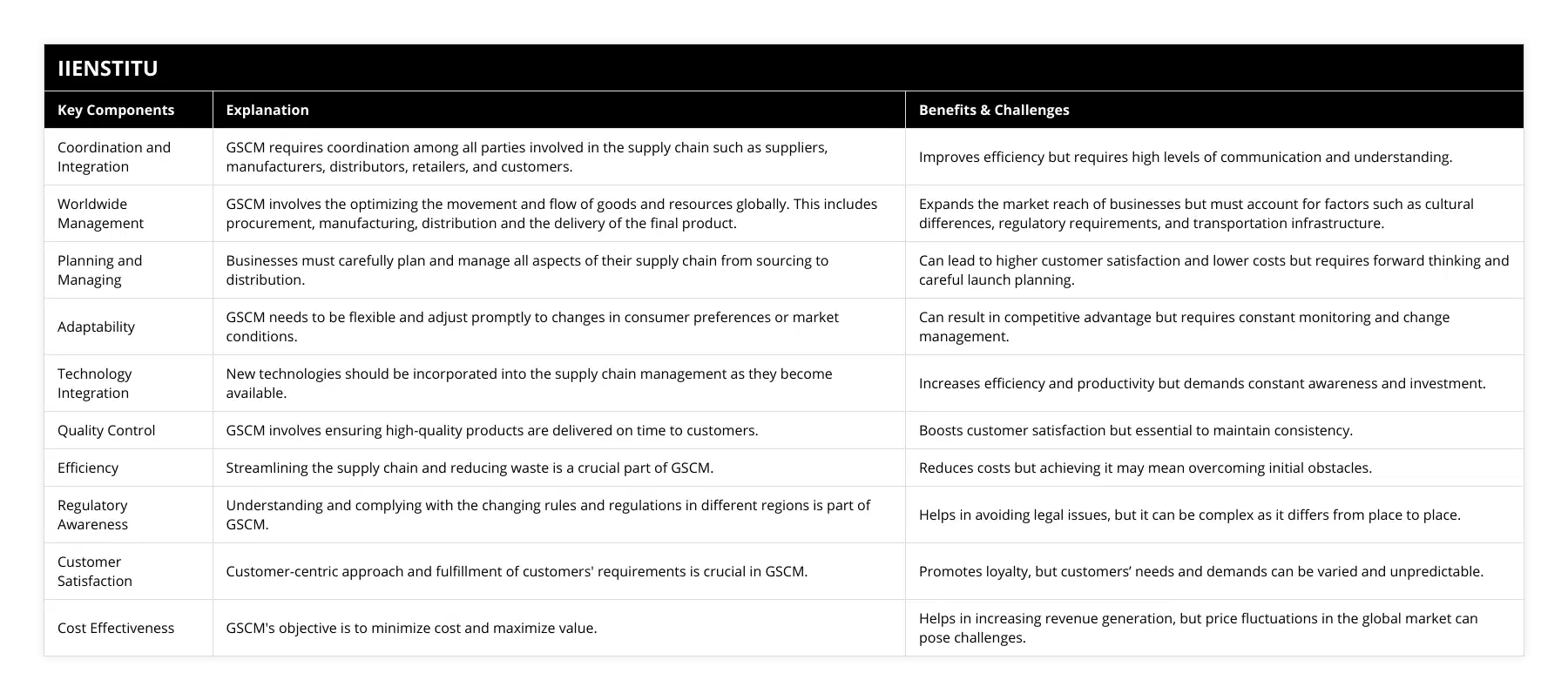
Frequently Asked Questions
What is global supply chain management?
Global supply chain management refers to overseeing the movement of goods and materials from suppliers to customers. This includes managing transportation, inventory levels, warehousing, and other elements critical to ensuring an efficient and cost-effective supply chain. For global supply chains to be successful, it is essential to monitor factors such as local regulations, currency fluctuations, and demand trends. In addition, effective communication with suppliers and customers is crucial to minimize delays or disruptions at any point along the journey. Overall, global supply chain management requires strategic planning and attention to detail to ensure a smooth operation.
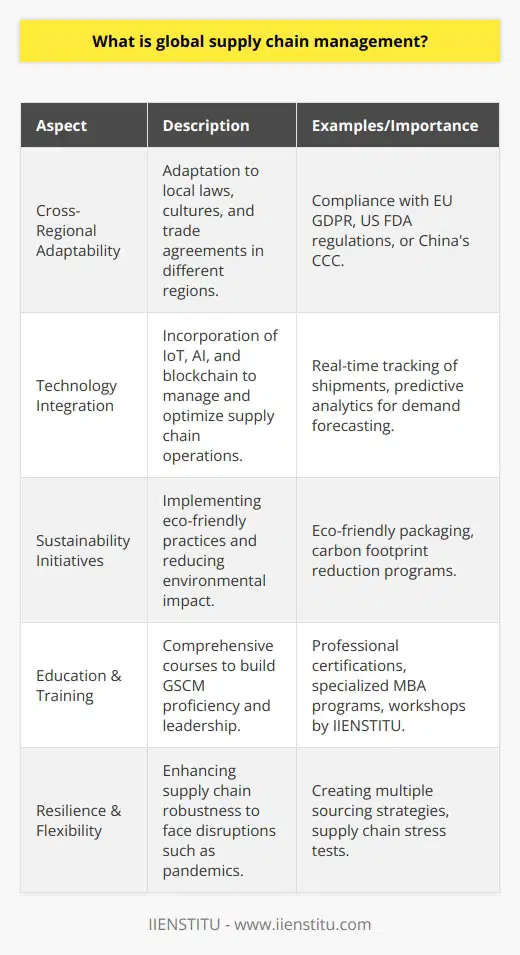
What are the benefits of implementing a global supply chain management system?
There are several benefits to implementing a global supply chain management system. First and foremost, such a system enables companies to more efficiently manage their inputs, inventory, and processing of raw materials. By having better control over their supply chains, companies can reduce costs and improve efficiency in the production process. Additionally, by streamlining the movement of materials from one location to another, they can minimize issues related to unscheduled downtime or unforeseen delivery delays.
Furthermore, a well-designed global supply chain management system can facilitate collaboration between suppliers and producers, leading to faster product development and more significant innovation within the industry. Ultimately, by implementing an effective supply chain management system, businesses can gain a competitive edge in today's fast-paced global marketplace.
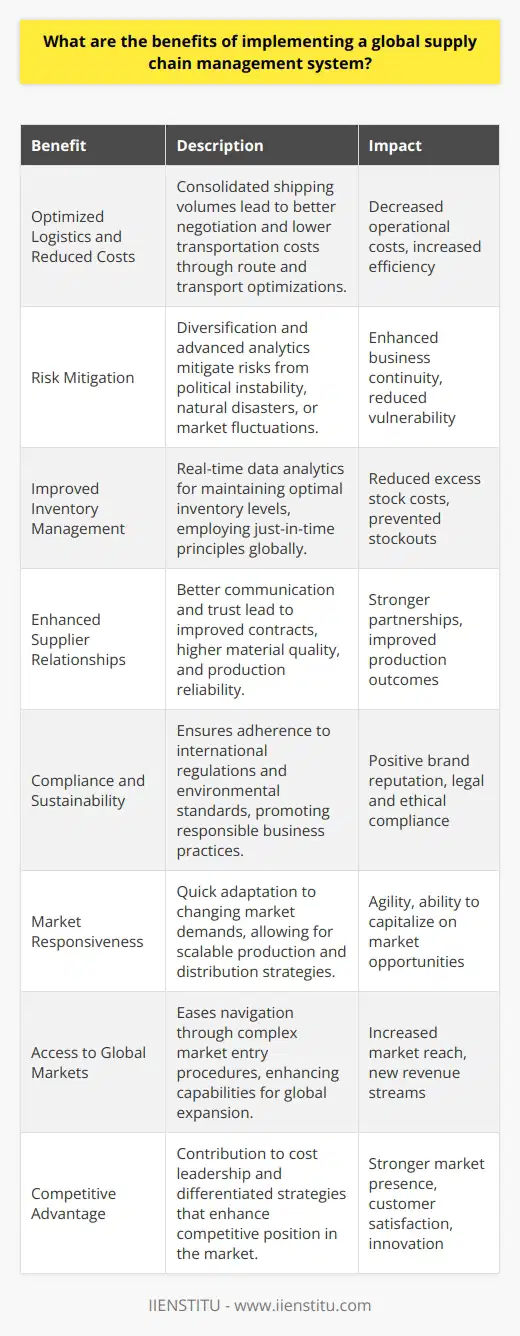
How can a company successfully manage a global supply chain?
Managing a global supply chain is no easy task. A company must balance competing for needs from each of its local partners and suppliers while remaining responsive to market changes. Several strategies can be used to manage this complex process, including maintaining clear communications with suppliers, utilizing data analytics tools to identify trends and risks, and creating systems for rapid decision-making. A thriving global supply chain ultimately requires an ongoing commitment to collaboration, innovation, and flexibility. By working diligently to address these key components, a company can ensure that it is always able to meet the needs of its customers around the world.

What are some of the challenges involved in maintaining a global supply chain?
Maintaining a global supply chain is a complex and challenging task. There are many factors to consider, including the current state of the economy, international regulations on trade and shipping, demand for specific products in different regions, and changing consumer preferences. Additionally, particular issues in the supply chain could arise at any point that might require quick action from stakeholders to prevent significant disruptions or problems. For example, expenses may rise unexpectedly due to increased fuel costs or currency exchange rates, or products may be delayed due to natural disasters that affect transportation routes. Overall, managing a global supply chain requires careful planning and constant vigilance to ensure that the process proceeds smoothly and efficiently.

Are any specific tools or software used in global supply chain management?
In the field of global supply chain management, a number of tools and software are commonly used to help businesses better manage their operations. One such tool is data analytics, which allows managers to visualize the movement of goods and personnel across the supply chain. By identifying bottlenecks and potential disruptions, data analytics can help companies to reduce costs and improve efficiency. Other useful tools for global supply chains include cloud-based platforms, which allow suppliers and retailers to store, access, and share important information in real-time. These platforms also make it easier for companies to collaborate with their partners, providing a more streamlined workflow throughout the entire value chain. Ultimately, anyone working in global supply chain management should be familiar with these essential tools and software to stay competitive in this fast-paced and ever-changing industry.
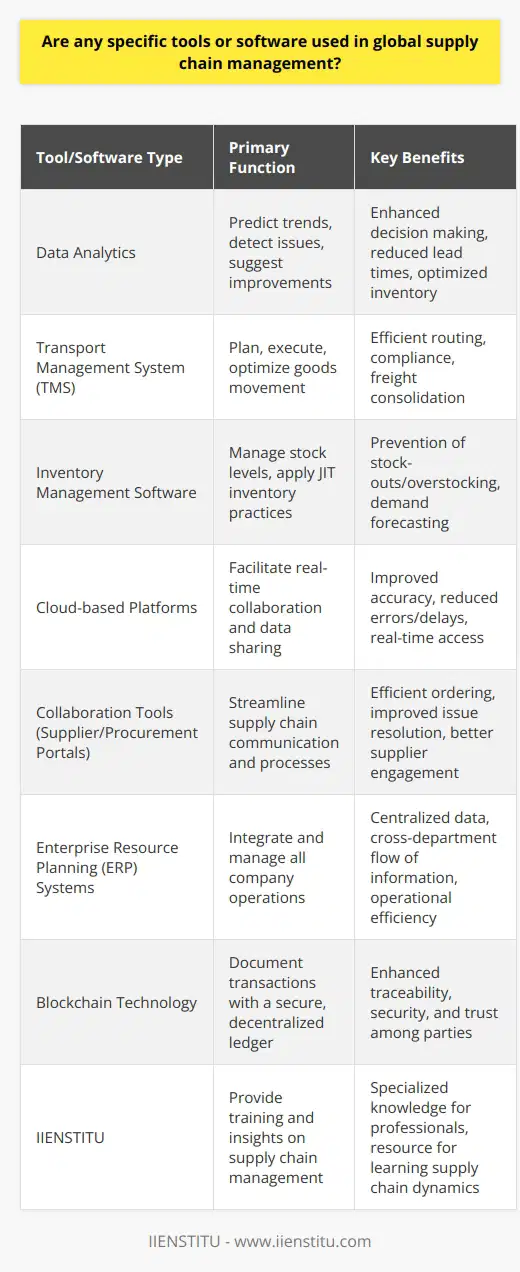
Could you give an example of how global supply Chain management would work in a business setting?
Global supply chain management is a critical component of modern business operations. This system requires coordination among multiple companies to ensure that the various features and resources needed to produce and deliver a product are efficiently and seamlessly brought together. To understand how this system works in practice, consider an example in the food manufacturing industry.
A large food manufacturer might partner with agricultural producers of various foods, such as fruits, vegetables, grains, and animal proteins. The manufacturer might also work with companies that handle logistics, produce packaging materials, and provide shipping services. By working with partners across the supply chain, the manufacturer can ensure that its resources are appropriately sourced, transported, and delivered to its production facilities on time. This helps to streamline operations by minimizing delays, reducing costs associated with managing inventory levels, and ensuring that customers receive high-quality products promptly. Ultimately, global supply chain management allows businesses to operate more efficiently and effectively in today's fast-paced and interconnected world.

What does global supply chain management do?
Global Supply Chain Management Overview
Global supply chain management (GSCM) is essential for businesses operating in today's interconnected marketplace. It refers to the process of coordinating and integrating the flow of products, information, and finances between companies that are operating in different countries. This includes activities such as procurement, production, transportation, and distribution, which all contribute to bringing a product from its initial source to its final consumer.
Benefits of GSCM
One key benefit of GSCM is its potential to reduce costs. By outsourcing production or sourcing materials from locations where they are more affordable, companies can achieve cost savings. Furthermore, collaborative relationships between suppliers and customers can lead to information sharing and increased efficiency in inventory management, resulting in a decrease in storage expenses.
Risk Mitigation in GSCM
Another critical function of global supply chain management is risk mitigation. With businesses relying on suppliers and partners located across the world, there is an increased potential for disruptions such as natural disasters, political events, or labor disputes. GSCM helps companies identify potential risks and create contingency plans, ensuring a smoother supply chain and minimizing the impact of unforeseen problems.
Sustainability and Compliance in GSCM
In an age of increasing awareness of corporate social responsibility, GSCM also addresses environmental and ethical issues. Environmentally-conscious companies must ensure that their suppliers abide by waste management and pollution control regulations. Additionally, they must adhere to policies regarding fair labor practices and human rights. By integrating these priorities into their supply chain management strategies, companies demonstrate a commitment to sustainability and compliance.
Technology in GSCM
The digital era has led to the rise of advanced technologies that assist in global supply chain management. Systems like Enterprise Resource Planning (ERP) software help automate processes, facilitating communication and data exchange between businesses in different locations. Tools such as the Internet of Things (IoT) allow for real-time tracking of shipments and improved inventory control.
In conclusion, global supply chain management plays a crucial role in the operations of businesses in today's increasingly interconnected world. By facilitating cost reduction, risk mitigation, sustainability, compliance, and the use of technology, GSCM contributes to a more efficient and stable supply chain, ultimately benefiting every link of the chain, from manufacturers to end consumers.
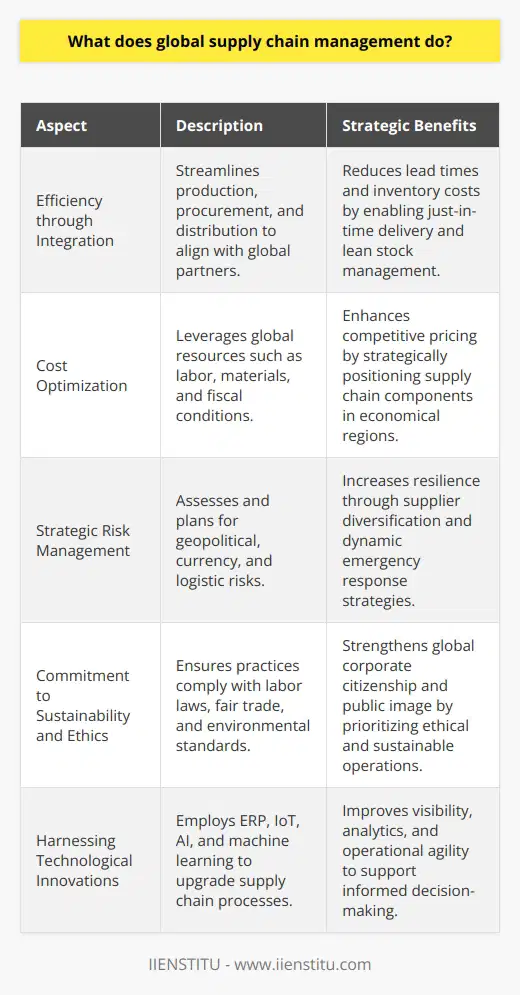
What is meant by global supply chain?
Understanding the Concept
A global supply chain refers to the network of interconnected businesses and activities involved in the procurement, production, and distribution of goods and services across international borders. This complex system encompasses various stages ranging from raw material extraction to final product delivery to end-users, facilitated by multilateral trade and investment agreements.
Key Components and Players
There are several vital elements within the global supply chain which include manufacturers, suppliers, logistics providers, and retailers. Manufacturers create products using raw materials sourced from suppliers, while logistics providers ensure the timely and efficient transportation of goods between production facilities, warehouses, and sometimes to retail outlets. Retailers, in turn, sell the finished goods to consumers.
The Role of Technology
Technology plays a crucial role in enhancing the efficiency and effectiveness of global supply chains. Advances in communication, transportation, and data analysis have revolutionized the way businesses operate and coordinate with one another, leading to greater access to markets, increased cost savings, and improved responsiveness to changing consumer demands. Examples of this include the Internet of Things (IoT), blockchain technology, and artificial intelligence (AI).
Challenges and Risks
Despite its myriad benefits, the global supply chain also presents several challenges and risks. Amongst these are geopolitical instability, disruptions due to natural disasters or pandemics, currency fluctuations, and trade disputes. Furthermore, ethical and environmental concerns such as unfair labor practices, environmental degradation, and infringement on human rights are increasingly scrutinized by consumers and regulators alike.
Strategies for Resilience
To mitigate these challenges and risks, businesses must adopt effective strategies promoting supply chain resilience. This may involve the diversification of suppliers and production facilities, investing in digital technologies to improve real-time response capabilities, and developing contingency plans for potential disruptions. Additionally, an increased focus on sustainable practices and adherence to ethical standards is essential to maintain consumer confidence and ensure long-term success.
In conclusion, the term 'global supply chain' signifies the intricate network of businesses and activities that contribute to the procurement, production, and distribution of goods and services across international borders. This model depends upon the harmonious collaboration of key stakeholders, advanced technological solutions, and proactive risk management to optimize efficiency and foster sustainable growth.
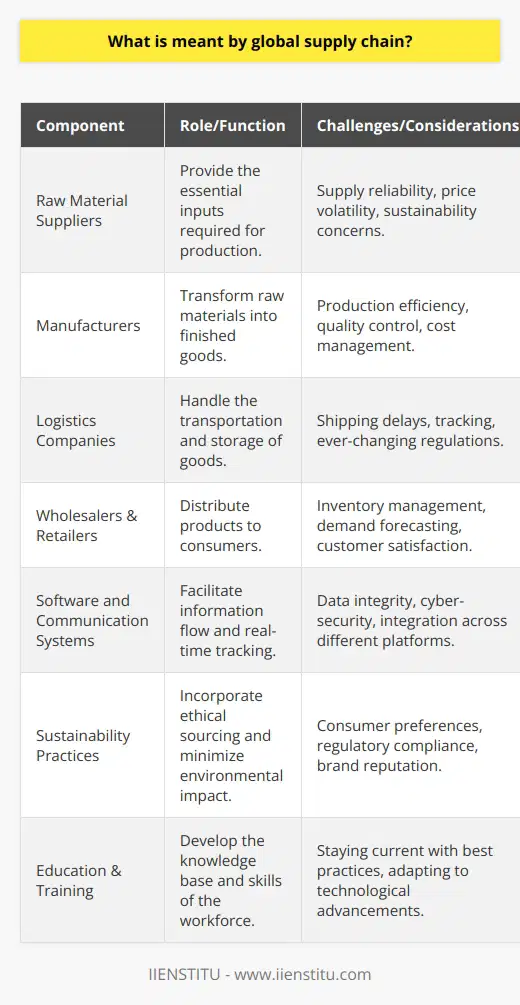
Is global supply chain management a good major?
Significance of Global Supply Chain Management Major
Undoubtedly, pursuing a major in Global Supply Chain Management (GSCM) can yield numerous personal and professional benefits for individuals. This field of study has gained significant importance in recent years, as organizations are increasingly relying on effective supply chain management for achieving a competitive advantage in the global market.
Career Opportunities and Growth
A primary advantage of choosing GSCM as a major is the plethora of career opportunities it presents, with professionals being in high demand globally. Students specializing in GSCM can pursue various roles, such as operations managers, logistics coordinators, purchasing managers, and supply chain analysts. Not only does a GSCM major provide diverse career options, but it also offers promising career growth, with opportunities to advance into higher management positions over time.
Transferable Skills Development
In addition to career-specific skills, a GSCM major also cultivates transferable skills such as critical thinking, problem-solving, and data analysis abilities. These skills are applicable across various industries, enhancing the employability of GSCM graduates. Furthermore, effective communication, negotiation, and teamwork skills are crucial for success in supply chain management positions, making GSCM students well-rounded professionals.
Global Perspective and Cultural Awareness
As the name implies, Global Supply Chain Management focuses on understanding and navigating international business environments. Consequently, GSCM majors develop a strong global perspective and cultural awareness, suitable for today's interconnected world. Such competencies are invaluable assets for organizations seeking to expand their operations, cater to diverse markets, or collaborate with international partners.
Contributing to Sustainability
Lastly, GSCM professionals play a critical role in driving sustainable business practices. They are responsible for optimizing operations, minimizing waste, and ensuring fair labor practices across the supply chain. By pursuing a GSCM major, individuals contribute to the global efforts in promoting environmental and social sustainability, ultimately making a positive impact on society.
In conclusion, Global Supply Chain Management is an excellent major, offering a wide range of career opportunities, skill development, and global perspective. Furthermore, GSCM professionals play a vital role in driving sustainable business practices, making it a fulfilling and socially responsible field of study.
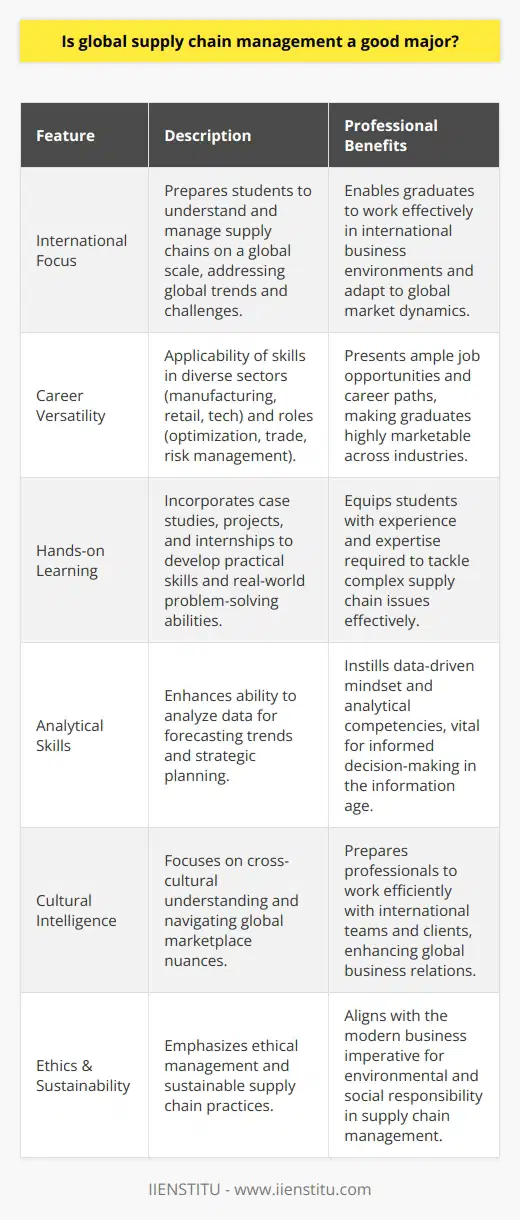
What are the key factors influencing the efficiency of a global supply chain?
Supply Chain Efficiency Factors
Geographically Dispersed Networks
One of the primary factors influencing the efficiency of global supply chains is the geographic dispersion of their networks. A geographically dispersed supply chain can lead to increased lead times, transportation costs, and coordination complexity. As such, organizations must carefully plan and manage their supply chain operations to optimize time and cost efficiency.
Technology and Automation
The adoption of technology and automation in the supply chain is another crucial factor that impacts its efficiency. Solutions such as warehouse management systems, IoT sensors, and data analytics tools, can help organizations streamline processes, optimize inventory levels, and reduce human error. Moreover, technological advancements such as blockchain and artificial intelligence can improve visibility and communication across the supply chain.
Demand Forecasting and Collaboration
Accurate demand forecasting and close collaboration between different stakeholders in a supply chain can significantly improve its efficiency. Sharing information and creating coordinated plans among suppliers, manufacturers, and retailers can reduce stockouts, excess inventory, and capacity constraints. Additionally, collaborating with third-party logistics providers can optimize routing, scheduling, and overall transportation efficiency.
Risk Management and Resilience
The exposure to numerous risks, such as natural disasters, geopolitical tensions, and market fluctuations, makes global supply chains vulnerable to disruptions. An essential determinant of supply chain efficiency is an organization's ability to effectively identify, monitor, and mitigate such risks. Building a robust and flexible supply chain, as well as maintaining contingency plans, can help organizations to minimize the impact of disruptions and maintain efficiency.
Lean and Green Initiatives
Implementing lean and green initiatives can have a significant positive effect on supply chain efficiency. Lean principles focus on eliminating waste and improving resource utilization, while green initiatives emphasize environmental sustainability and responsible use of resources. By implementing these approaches, organizations can not only reduce costs and optimize supply chain operations but also contribute to environmental stewardship.
In conclusion, the efficiency of global supply chains is influenced by a combination of factors, such as geographic dispersion, technology adoption, demand forecasting, risk management, and lean and green initiatives. By concentrating on these aspects, organizations can optimize their supply chain operations, reduce costs, and ensure a smooth flow of goods and information.
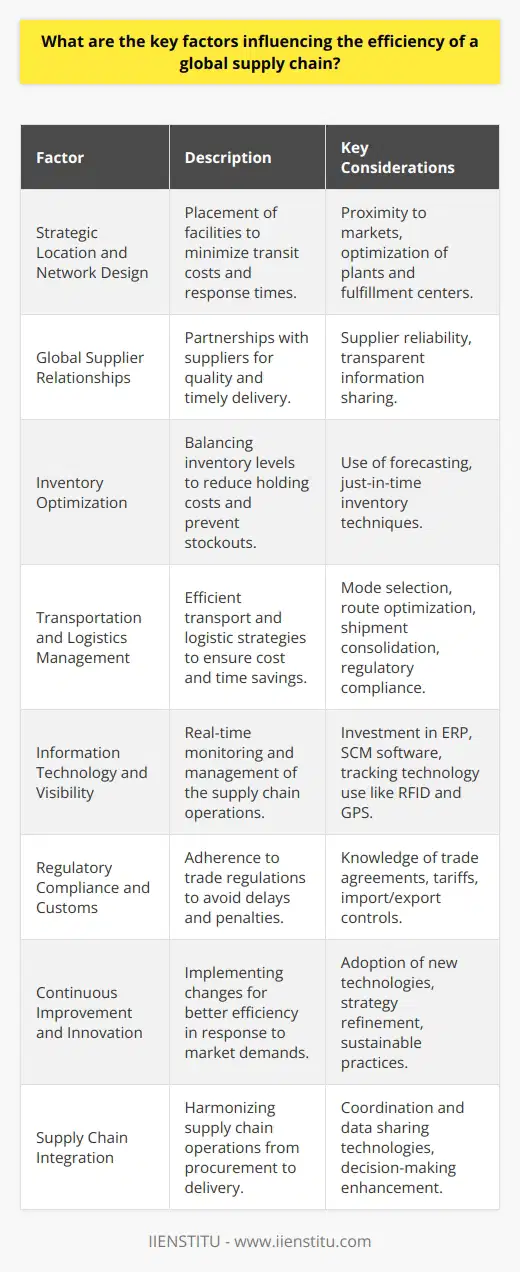
How do geopolitical factors impact global supply chain management?
Geopolitical Factors and Global Supply Chain Management
Geopolitical factors, including political instability, economic policies, and trade relations, play a critical role in shaping global supply chains. Political instability in a region can disrupt the production and distribution of goods, leading to increased costs and vulnerable supply chains. For instance, conflict or civil unrest can hinder transportation routes, impede access to necessary resources, and strain relationships with key suppliers and customers.
Economic Policies and Supply Chain Effects
Governments implement various economic policies that significantly influence global supply chain management. For example, protectionist measures, such as tariffs and quotas, increase the costs associated with importing and exporting goods. Additionally, these measures can lead to retaliatory actions from other countries and affect the competitiveness of firms in the global market. Furthermore, fluctuating exchange rates can cause difficulties in forecasting prices and managing budgets.
Trade Relations and Collaboration
Trade relations between countries are essential for smooth global supply chain operations, as they facilitate access to necessary resources and markets for selling finished goods. Bilateral and multilateral trade agreements promote the exchange of goods and services between nations, enabling more stable and predictable business environments. However, strained trade relations can result in restrictions or embargoes, making it harder for companies to access specific markets or resources, driving up costs and potentially causing delays in production.
Regulatory Compliance and Environmental Concerns
Companies operating in different countries must also adhere to various regulations regarding environmental and ethical matters. Non-compliance to these regulations can lead to fines, reputational damage, and even disruption of business operations. Moreover, growing concerns about climate change and the increasing importance of sustainability practices have pushed firms to incorporate these considerations into their supply chain strategies. For example, companies are now focusing on circular economy principles, reducing waste, and lowering their carbon footprint to remain competitive and responsible.
Adapting to Geopolitical Uncertainties
To navigate geopolitical challenges in global supply chain management, firms must develop strategies to mitigate risks, adapt to changes quickly, and enhance resilience. Diversifying suppliers, markets, and transportation routes is one way to reduce dependence on specific regions or resources. Moreover, incorporating technology, such as supply chain digitization and data analytics, can aid in monitoring risks and identifying alternative strategies. Close collaboration with suppliers, customers, and governments can also help businesses tackle geopolitical uncertainties effectively and maintain smooth global supply chain operations.
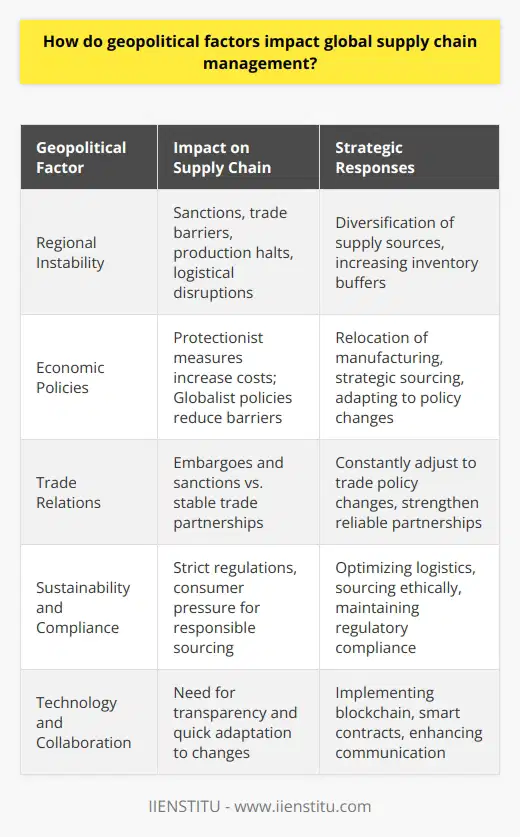
What role do logistics and transportation play in the successful execution of global supply chain strategies?
Role of Logistics in Global Supply Chain Strategies
Logistics and transportation are essential components of global supply chain strategies, ensuring the efficient and effective movement of goods from manufacturers to consumers. Through a combination of transportation networks, warehousing, and inventory management techniques, logistics service providers ensure timely deliveries and maintain product quality, contributing to the overall performance of supply chain operations.
Transportation: Connecting Producers and Consumers
A robust transportation infrastructure connects various nodes in the supply chain, enabling seamless deliveries across international borders. Integrating air, maritime, road, and rail networks, highly efficient transportation systems enhance the flexibility and responsiveness of supply chain operations. This integration aids in meeting customer expectations, mitigating production delays, and reducing lead times, thus positively impacting overall profitability.
Warehousing: Storage and Distribution Optimization
Effective warehousing strategies support logistically efficient storage and distribution, catering to the needs of fluctuating market demands. With the implementation of advanced technology, such as automation, robotics, and real-time tracking systems, warehouse operations can minimize wastage and manage inventory levels more effectively. This optimization helps meet consumer demands while maintaining the desired level of customer satisfaction.
Inventory Management: Balancing Supply and Demand
Inventory management is a crucial aspect of logistic operations, enabling companies to maintain an optimal balance between supply and demand. This balance prevents stockpiling or stock-out situations, optimizing costs and sustaining product availability. Employing predictive analytics and demand forecasting techniques further bolsters inventory management efficiency, promoting proactive decision-making, and reducing risks associated with unexpected disruptions or fluctuations in global markets.
Collaboration: Strengthening the Supply Chain Network
Active collaboration between supply chain stakeholders, such as suppliers, manufacturers, logistics providers, and retailers, is crucial for the successful execution of supply chain strategies. Collaborative partnerships streamline communication, enhance transparency, and speedup decision-making processes that impact transportation and logistics operations. This pooling of resources and expertise results in a more efficient and resilient supply chain network, better prepared to face the challenges of a globalized and interconnected world.
In conclusion, logistics and transportation play a pivotal role in the successful execution of global supply chain strategies. By ensuring the efficient movement of goods, optimizing warehousing and inventory management, and fostering strong collaborative relationships, these components contribute significantly to operational efficiency and the overall financial performance of businesses. In today's increasingly interconnected world, effective logistics and transportation management are vital to maintaining a competitive edge in the global marketplace.
